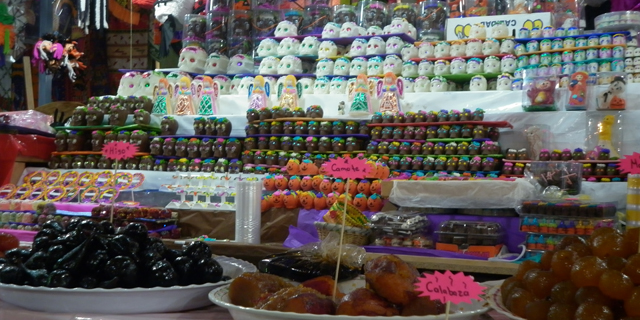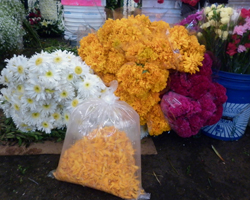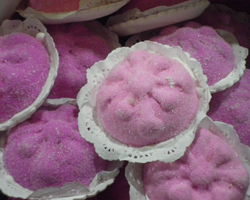Rows and rows of sticky, crystallized figs, pears, and pumpkin slices sit beside skulls made from amaranth seed, dipped in chocolate, and delicately decorated with googly eyes and streaks of colored frosting. Mounds of sugar-brushed pan de muerte fill the air with the scent of orange-blossom. Everywhere you look are papel picado flags with images of dancing skeletons and tombstones. It’s a world of the dead. At least, that is, the Mexican dead, who are honored each year from October 31st to November 4th during Día de los Muertos.
Like most holidays, this tradition revolves around good food. Sweet and savory offerings to deceased family members are placed at the foot of tombstones and include everything from plates of pollo con mole to shots of tequila to skulls made of sugar, all surrounded by massive piles of orange marigolds, the official Day of the Dead flower.
“It’s a day to re-encounter your dead relatives,” says Armando Romero, a young dreadlocked maker of paper mâché skulls. “It’s way to break with individualism, to realize that it’s not just you (in the world), but the rest of your family too. The idea is to go (to the graves of the dead) and that they will be there.”
Mexico City’s Jamaica market is one of the best places to be the weeks before Día de los Muertos. The smells of woodsmoke, lilies, and copal incense all fight for your nose’s attention while the sheer quantity of burnt orange cempasuchils, bright purple flor de muerto, and white nubes blur your vision. This market is one of the oldest in the city and more than 60 years ago was located along the side of the Viga canal that ran through this neighborhood. Javier Escamilla’s grandparents used to sell along the canal’s edge and now he has a small stand (passed down from his mother) with shoe and packaging supplies in the market’s household goods section.
“I grew up here in the nursery,” he says. “I’ve been here in the market all my life.” He tells me that part of the market was destroyed in the 1985 Mexico City earthquake and locatarios (as the shop owners are called) had to fight with the government to rebuild the market on the same land, which at that point had become a very valuable piece of city property. Before the earthquake the market only sold its famous flowers and fruits and vegetables. These days, everything is for sale here. During this time of year you can get a sugar high just walking into the place. There’s a mix of Dia de los Muertos and Halloween imagery but the season’s traditional Mexican candies are always present.
Next, a look at the traditional sweets available for Dia de los Muertos…
[pagebreak]“The traditional sweets are (crystallized) sweet potato, pumpkin, and chayote along with sweet nut bars, pumpkin seeds, and almonds, nothing more. In the past twenty years lots of varieties have emerged,” says Jaime Gutierrez, a candy maker, pointing to mounds of chocolate covered amaranth bars in the shape of witches and ghosts. “We also make things like sweet chiles rellenos. We take poblano peppers, but instead of cheese or meat, we fill them with coco.”
Gutierrez’s family has been making Mexican candy for four generations in the town of Santa Cruz Acalpixca, just south of Xochimilco in the outskirts of Mexico City. On the day I visited his shop he had soupy vats of sweet potato and pumpkin slices floating in honey, fat, sugary balls of tamarind paste piled on top of one another, and roasted walnut bars made with piloncillo, Mexican brown sugar.
Some of my favorite altar offerings are the tiny marzipan figurines shaped into watermelon slices, plates of mole, and loaves of bread. For children’s day of the dead on November 2 there are lambs and baby dolls made of sugar and always a loaf of pan de muerto.
Abril Diaz Cruz, the pastry chef of La Cereza bakery in Mexico City’s Roma neighborhood, told me that the squeamish Spaniards, when they showed up in the new world, weren’t thrilled about the Aztec custom of biting the bloodied, beating heart of their human sacrifices to pass on the spirit of the dead to the person conducting the ritual. The Spanish insisted that the hearts be replaced with a heart-shaped sweet bread painted red and decorated with two bread “bones” and a bread “skull” that could then be eaten without making anyone queasy.
In the final days of October, cemeteries all over Mexico begin to be transformed with these offerings. Relatives may hold all-night vigils for deceased family members, which just need a little tequila and some good food to become full blown parties.
“We’re not a afraid of death,” a good friend once told me about Mexicans. “Those who are gone are just as real as when they were here.” So you’re just as likely to get a sugar-induced coma as Halloween, but the ghosts and ghouls are your Aunt Frida and Uncle Diego and nothing to be afraid of.
Even though every year families are more likely to buy their paper mâché skulls or pan de muerto than make their own, these traditions are still deeply ingrained in the Mexican psyche and it only takes one experience with the Day of the Dead for it to be deeply ingrained in yours too.




![Making Mealtime Matter with La Familia: Easy Sofrito [Video]](https://thelatinkitchen.com/wp-content/uploads/2015/10/sofrito-shutterstock__0-500x383.jpg)
![Easy Latin Smoothies: Goji Berry Smoothie [Video]](https://thelatinkitchen.com/wp-content/uploads/2015/12/goji_berry-shutterstock_-500x383.jpg)
















![Fun and Fast Recipes: Fiesta Cabbage Salad [Video]](https://thelatinkitchen.com/wp-content/uploads/2015/11/fiesta_cabbage_slaw-shutterstock_-500x383.jpg)









